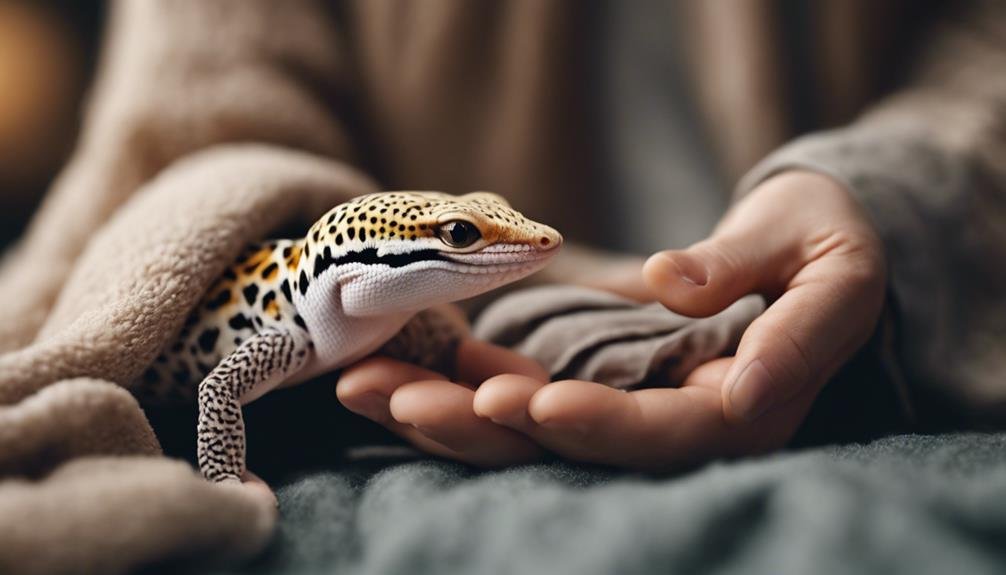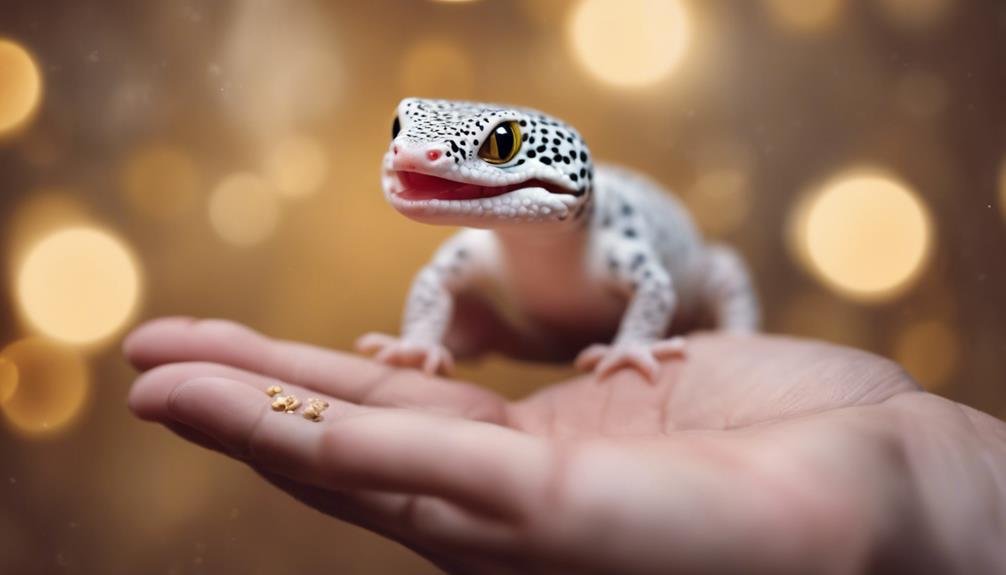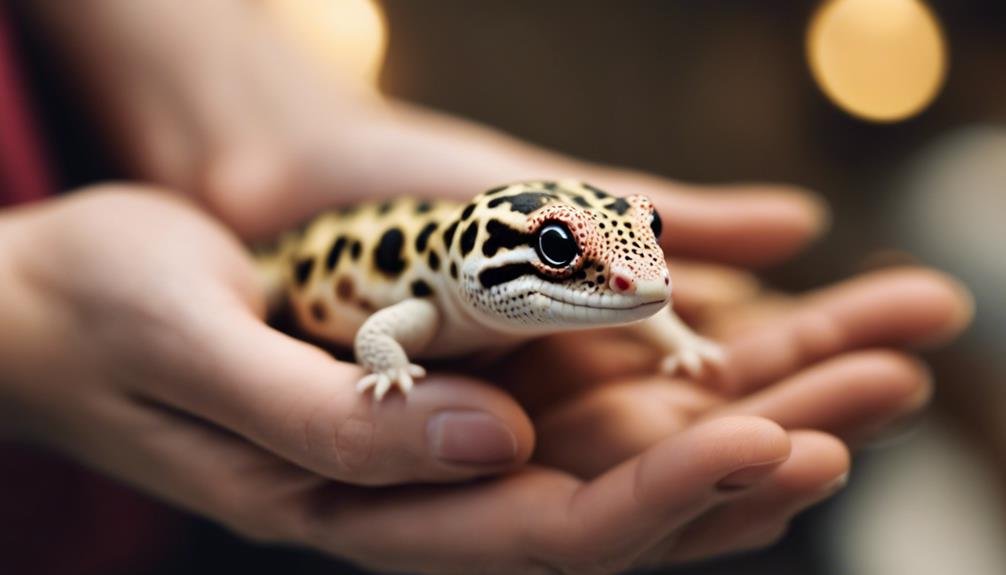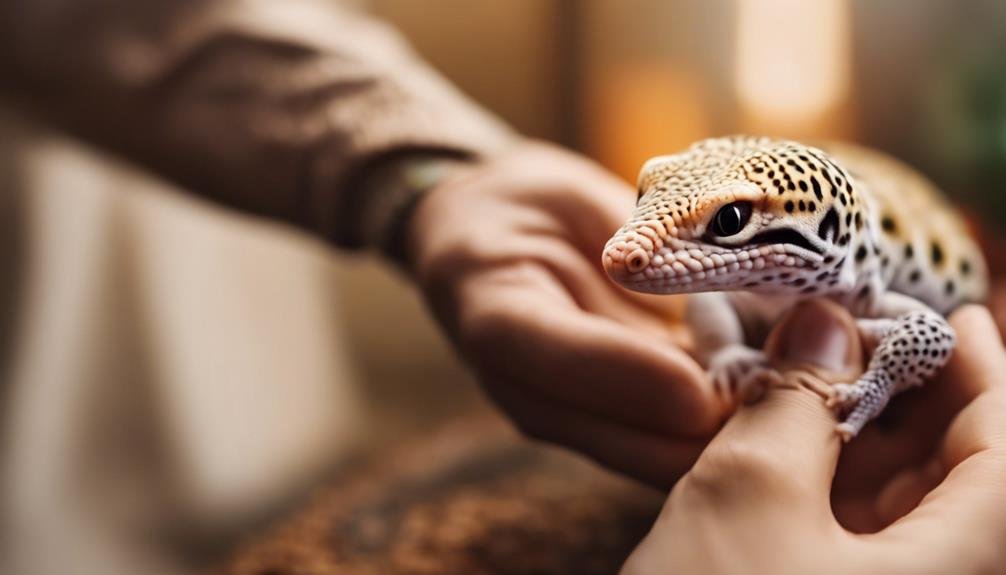If you’ve ever wondered whether your leopard gecko enjoys being held, you’re not alone. These solitary creatures show a range of preferences towards human interaction, and it’s crucial to approach them with care. You’ll need to learn the subtle art of recognizing their comfort and stress signals, a skill that could transform your relationship. Mastering the right techniques for gentle handling and establishing a routine can make all the difference. But how exactly do you start, and what signs should you look for to guarantee your scaly friend is as happy to be with you as you are with them? Let’s explore the nuances of building trust with these fascinating reptiles.
Key Takeaways
- Leopard geckos are solitary and prefer minimal handling, but can enjoy gentle interaction once accustomed.
- Gradually introducing handling, starting with short periods, helps build trust without causing stress.
- Recognizing signs of comfort and stress is crucial; tail waving or hissing indicates they need space.
- Proper handling techniques involve gentle lifts, avoiding the tail, to ensure the gecko feels secure.
- Positive reinforcement, like offering treats during interaction, can create a positive association with being held.
Understanding Leopard Geckos
To truly appreciate leopard geckos, it’s important to understand that they’re solitary creatures by nature, thriving best when left to their own devices. This fundamental aspect of their behavior influences how you should approach building a relationship with your gecko. Unlike many social animals that seek companionship, leopard geckos are content with solitude. They prefer spending their time hunting, exploring, or sleeping without the company of others. This doesn’t mean they can’t form a bond with you; it’s just that their signs of comfort and curiosity might look different from what you’d expect.
Building a relationship with your gecko involves recognizing their unique needs and behaviors. Since they don’t require or often appreciate the company of other geckos, introducing them to your family is more about letting them associate you with positive experiences. They may start to see you as a source of warmth, protection, and food, rather than a companion in the traditional sense. Remember, forcing social interactions or cohabiting them with other geckos can lead to stress or aggression due to their territorial nature. Understanding these nuances is key to a healthy and happy relationship with your gecko.
Initial Acclimation Process
As you guide your leopard gecko through its initial acclimation, it’s essential to understand their comfort zone, introduce handling gradually, and recognize signs of stress.
You’ll start by giving them space, then slowly integrate your presence in a non-threatening manner. This approach helps build a strong foundation of trust and comfort, paving the way for a healthy human-gecko relationship.
Understanding Their Comfort Zone
When you first bring a leopard gecko home, it’s important to give it a couple of weeks alone to reduce stress and let it adjust to its new surroundings. This period helps your gecko feel safe and secure in its new environment. Here’s a breakdown of steps to encourage comfort and safety:
| Action | Purpose |
|---|---|
| Avoid handling | Reduces stress, helps gecko feel safe |
| Maintain enclosure | Promotes stability, fosters security |
| Encourage natural behavior | Aids in comfort, establishes routine |
| Introduce gentle movements | Familiarizes gecko with your presence |
| Talk softly near enclosure | Builds positive association, enhances comfort |
Gradual Handling Techniques
Once your leopard gecko starts feeling at ease in its new home, it’s time to gently introduce handling, ensuring you build trust from the start. Here’s how to make the process as smooth as possible for both you and your gecko:
- Allow exploration: Let your gecko explore your hand at its own pace to build familiarity, avoiding any sudden movements.
- Avoid the tail: Never grab your gecko by the tail, as this can cause stress and potential harm.
- Lift carefully: Gently slide your fingers under the gecko’s midsection for a secure yet comfortable grip.
- Provide support: Use your other hand to offer additional support, giving your gecko a sense of security and stability during handling.
Signs of Stress
Understanding the signs of stress in leopard geckos during their initial adjustment period is vital for their health and happiness. When you bring your gecko to a new home, it’s important to watch for behaviors indicating they’re not yet comfortable. Here’s a quick guide to spot stress signs:
| Sign of Stress | Description |
|---|---|
| Excessive Hiding | Staying hidden more than usual could indicate discomfort. |
| Refusal to Eat | Skipping meals can be a stress response. |
| Erratic Movements | Sudden, unpredictable movements when handled. |
These signs, including darkened appearance or rapid breathing, reveal your gecko is still adapting. Be patient and give them time to acclimate to their new surroundings, ensuring a smooth adjustment to feeling safe and secure in their new home.
Signs of Comfort and Stress
Recognizing the signs of comfort and stress in leopard geckos is fundamental for their well-being, as they communicate through specific behaviors and body language. When your gecko feels at ease in your presence, it’s a positive thing. They might curl up on you, enjoying your warmth, or explore around, indicating they’re comfortable and secure with you. On the flip side, observing any signs of stress is important to prevent potential health issues.
Here’s what to look out for:
- Comfort Signs:
- Curling up or exploring your warmth, which shows they’re relaxed and feeling safe.
- Exhibiting relaxed body language, a clear indicator of their comfort and security.
- Stress Signs:
- Tail waving, hissing, and attempts to escape signal they’re feeling threatened or uncomfortable.
- Decreased appetite or weight loss can be a sign of prolonged stress, leading to health complications.
Understanding and recognizing these signs are essential. It allows you to make sure your leopard gecko’s environment and handling are conducive to their happiness and health.
Handling Techniques


To guarantee your leopard gecko’s comfort and safety, you’ll need to master proper handling techniques, starting with gentle, supportive lifts. It’s important to allow your gecko time to explore and become accustomed to your presence before attempting to pick them up. This approach helps prevent any stress or fear that could inadvertently associate you with food, which is a situation you want to avoid.
When you’re ready to lift your gecko, never grab them by their tails. Instead, slide your fingers under their midsection and gently scoop them up, using your other hand to support them. This method ensures your gecko feels secure and supported during the handling session.
Be mindful of your gecko’s movements and reactions while you’re holding them. They’re quick and can be unpredictable, so staying prepared for any sudden moves is important. Additionally, focusing on bonding strategies, like spending quality time together, understanding their preferences, and respecting their boundaries, will enhance your interactions.
Monitoring their comfort level, ensuring the environment is calming, and checking their belly temperature are key practices to keep your gecko feeling at ease in your hands.
Building Trust Over Time
After mastering the basics of handling your leopard gecko, it’s time to focus on how to build trust over time, ensuring a stronger bond between you and your pet. Trust-building is a gradual process, emphasizing patience and understanding of your gecko’s needs and comfort levels. Here are key steps to bear in mind in this journey:
- Gradually Introduce Hand Interactions: The first step involves slowly getting your gecko accustomed to your presence. Start by placing your hand still inside the enclosure, letting them approach you on their terms.
- Avoid Sudden Movements: Move slowly and predictably around your gecko to avoid startling them. Quick or abrupt motions can undermine trust, making them feel threatened.
- Respect Their Boundaries: Pay attention to your gecko’s body language. If they seem uncomfortable or try to escape, give them space. Allowing them to initiate contact can notably boost their confidence around you.
- Consistent, Gentle Handling: Regular, but not excessive, gentle handling sessions can help your gecko become more comfortable with you over time. Consistency is key to reinforcing their sense of security when around you.
Building trust with your leopard gecko won’t happen overnight, but with patience and consistent gentle interactions, you’ll form a lasting bond.
Positive Reinforcement Strategies


Integrating positive reinforcement strategies, such as offering treats, can greatly enhance your bond with your leopard gecko by creating a rewarding interaction for them. Positive reinforcement involves using food and treats to foster a positive association with handling. This approach helps build trust and comfort between you and your gecko, essential for a healthy relationship.
By offering food by hand or using tongs, you’re not just feeding your gecko; you’re establishing a deeper bond. This method shows your pet that your presence brings good things, encouraging them to trust and interact with you more. Rewarding your gecko with food for positive behavior, like calmly accepting handling or coming towards you, reinforces these behaviors. It tells them that being close to you is safe and beneficial.
Paying attention to your gecko’s reactions is important. If they seem uncomfortable or stressed, it’s important to adjust your handling techniques. Positive reinforcement isn’t just about treats; it’s about understanding and responding to your gecko’s needs. By observing and respecting their comfort level, you’ll make every interaction a step towards a stronger bond.
Creating a Bonding Routine
Establishing a consistent handling routine is key to building trust and familiarity between you and your leopard gecko. This process involves more than just physical contact; it’s about creating a comfortable environment where your gecko feels safe and secure with your presence. To achieve this, consider the following steps:
- Spend Quality Time: Let your gecko get accustomed to you by spending time near its enclosure. This non-invasive approach allows it to observe you without feeling threatened.
- Gentle Movements and Sounds: Use slow movements and speak softly when you’re around your gecko. These actions help acclimate it to your presence, making future interactions more comfortable.
- Wait for Initiation: Always wait for your gecko to show interest in coming closer before attempting to handle it. This patience respects its comfort level and autonomy.
- Introduce Your Hand Gradually: Let your gecko investigate your hand at its own pace. This method promotes a sense of safety and encourages choice in your interactions.
Play and Interaction Ideas


Having laid the groundwork for a trusting relationship, it’s now time to explore play and interaction ideas that will enrich your leopard gecko’s life. Introducing a variety of safe, interactive toys within their enclosure can greatly enhance their environment. Think about incorporating tunnels, branches, and climbing structures to encourage their natural behaviors and keep them actively engaged. These elements not only stimulate their minds but also promote physical activity.
Creating a safe, supervised play area outside their enclosure offers them a new space to explore under your watchful eye. Here, your leopard gecko can experience a change of scenery and a bit of adventure, making each interaction a novel experience. Additionally, gentle hand-guided exploration sessions can further their comfort with handling, fostering a deeper bond between you both.
Recognizing Individual Preferences
Leopard geckos often show distinct preferences for how they’re handled, so it’s crucial to observe and respect their individual comfort levels. Each gecko starts from a unique place of comfort when it comes to human interaction, and recognizing these differences is key to building a trusting relationship. Remember, what works for one gecko may not work for another, and patience is crucial.
Here are a few steps to keep in mind:
- Observation: Notice how your gecko starts to behave as you approach their enclosure. A relaxed posture versus a tense one can tell you a lot.
- Gradual Introduction: Start with minimal handling, and as your gecko starts to show signs of comfort, you can gradually increase the duration.
- Consistency: Keep interactions regular but not overwhelming. If your gecko starts to retreat or show stress signals, give them space.
- Respect Boundaries: If your gecko starts to show clear signs of discomfort, such as trying to escape, hissing, or biting, it’s a signal to stop and try again later.
Understanding and respecting each gecko’s individual preferences not only ensures their well-being but also enhances the bond between you and your pet.
How Can I Hold My Leopard Gecko Without Causing Stress?
When handling your leopard gecko, be sure to take proper leopard gecko stargazing precautions to avoid causing stress. Approach them gently, scoop them up from below, and support their body to keep them calm. Handle them in a quiet, calm environment, and avoid sudden movements to prevent stress.
Frequently Asked Questions
How Do Leopard Geckos Like to Be Held?
You’re curious about how leopard geckos like to be held, focusing on their comfort during handling. They prefer a light touch along their back, avoiding the tail, and need to feel supported. Make sure your grip is stable and secure.
Introducing food by hand can foster trust. It’s important to watch for stress signs and let them initiate contact for a positive experience. Remember, handling should always respect their boundaries for their comfort.
How Do Leopard Geckos Interact With Each Other?
You’re wondering how leopard geckos interact with each other, focusing on their social dynamics.
Well, they’re pretty solitary creatures and generally prefer to live alone. When they’re put together, especially males or mixed genders, you’ll likely see aggression and fighting.
It’s not just about territory; they can get stressed competing for food.
Are Leopard Geckos Interactive?
Yes, leopard geckos can be interactive, but not in the way you’d expect. Unlike mammals, they don’t seek out social interactions or display territorial behavior towards humans.
Instead, they might see you as a source of warmth and possibly associate you with getting food. They’re curious creatures and may enjoy exploring around you or even curling up in your hand, showing their comfort and trust in their unique, solitary way.
Do Leopard Geckos Like to Be Carried?
You might wonder if leopard geckos enjoy being carried. Generally, they don’t. They tolerate handling but prefer their own space. When you do pick them up, keep it short and sweet for their comfort.
They’re not fans of long cuddle sessions and may show stress or try to escape if held too long. Always prioritize their comfort during interactions, ensuring they feel safe and not overwhelmed by too much handling.
Conclusion
To sum up, you’ve seen that understanding and respecting your leopard gecko’s individual preferences is key to building a strong bond.
By mastering gentle handling techniques, paying attention to their comfort and stress signals, and incorporating positive reinforcement, you’ll gradually earn their trust.
Remember, every gecko is unique, so what works for one may not work for another. Keep experimenting with play and interaction ideas, and you’ll find the perfect way to connect with your scaly friend.


